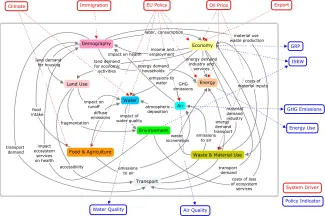
System Dynamics models: crucial to long-term decision-making
Policymakers don’t just make baseless decisions – they rely on information systems. However, the available calculation models are often too complicated and are difficult to apply to a policy-making context. Therefore, we need well-designed systems to support policymakers. Systems that are user-friendly, flexible and fast. VITO creates this kind of information systems, in the shape of System Dynamics (SD) models.
What is a System Dynamics model?
System Dynamics models consistently describe the interactions between various themes within a system (like economics, demographics, energy and spatial use).
Thanks to these models, policymakers can coherently calculate various combinations of scenarios and policy choices and determine their long-term impact.
The focus mainly lies on the feedback that can influence the behaviour of a system and, therefore, determine the way the system responds to a certain policy. Think, for instance, of the impact of climate change on the ocean food web and the coastal economy (for the EU-FP7 project OceanCertain).

What does a Systems Dynamics model look like?
An SD model shows a complete overview of the system at hand, with the main outline and the feedback that is used to describe the relationships between the subindustries and subthemes.
The benefits of System Dynamics models
- Their consistency, flexibility, transparency and calculation speed are what makes the SD models so handy.
- The graphic design and interactivity of the models are a huge advantage when you work with stakeholders and end users. Everything is presented very clearly in a visual way. Any adjustments you make are immediately factored into the bigger picture.
- The transparent interface allows visitors to calculate combinations of measures and scenarios quickly to the desired level of detail.
- The models are very practical and can be used by policymakers to analyse, compare and prepare various policy strategies.
Want to learn more about System Dynamics modelling?
Want to learn more about System Dynamics modelling?
FAQ: System Dynamics modelling
The goal of System Dynamics modelling is not so much delivering an in-depth prognosis. This tool is meant to expose so-called tipping points in which system behaviour changes considerably – let's say the point where the system switches from balanced to imbalanced.
Examples of systems VITO was involved in:
-
An inventory tool for pollutive emissions in waterways (WEISS, SOLUTIONS) and tools for total river management (Elbe DSS, Schelde)
-
Sustainable agriculture (MultiMode)
-
Climate adaptation (OCEAN-CERTAIN)












